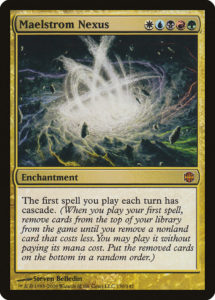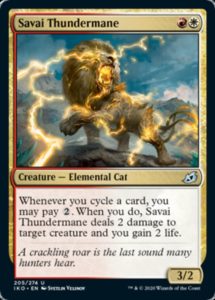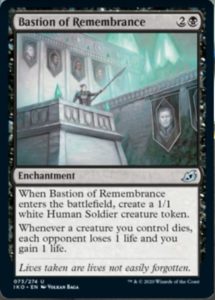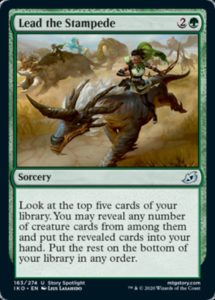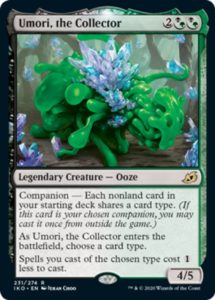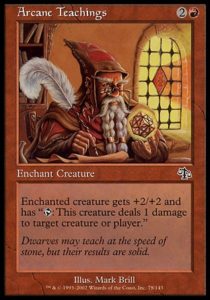Ikoria is here and it is a wild format! It features a sweet new take on Cycling, a fun and skill-intensive new mechanic in Mutate, and a Limited format that seems to combine two parts Rise of the Eldrazi with three parts Unstable—a Jenny/spike format where you can customize your own creatures, stretch your mana to the breaking point, and sacrifice crunchy humans for value.
I’ve been having a blast with the format. With all this extra at-home time I’ve got, I’ve managed to complete a playset of Ikoria (something I’ve never tried to do) and earn about 20,000 gems in one week purely by drafting and then cracking almost two hundred packs when I was done. Last time, we did a broad overview of Ikoria Limited before it released. This time, with plenty of experience under our belt, we’ll focus on the particulars of the major archetypes.
The first thing to know is that Ikoria is very different from the last multicolor sets we saw on Ravnica—yes, it rewards you for finding an open lane and committing to it, but there aren’t five or ten discrete archetypes based on color pairs. Ikoria is defined by three modular things: Mutate (all colors have Mutaters and non-human Mutatees, though white really struggles), Cycling (which provides consistency and its own archetype), and plentiful fixing. These flexible factors blur the borders across archetypes by letting them use each other’s components. So while there is support for UR noncreature-matters, Wrb go-wide, and BG graveyard shenanigans, these are usually minor themes subsumed within broader archetypes. I’d argue that there are five such archetypes: Multicolor Goodstuff, Cycling, Humans, two color Mutate, and Companion.
We’ll start with what I drafted the most at the onset: Multicolor Goodstuff.
Taste the rainbow
Plentiful fixing, powerful shenanigans, excellent card smoothing, and anemic aggro decks are perfect conditions for multicolor goodstuff piles to shine. The goal’s simple: play three or more colors, get rewarded. Each wedge does things a bit differently, but it ultimately doesn’t matter which colors you draft. Your goal is less a tightly-constructed deck with deep Mutate/Cycling/noncreature-matters/tokens synergies and more overpowering your opponent with high card quality.
Drafting this archetype requires discipline, since you’re going to save filling out your curve until later on in the draft. Early on, you need to prioritize three things: bombs, high quality removal (Blood Curdle and Fire Prophecy, not Gust of Wind or Clash of Titans), and fixing. Farfinder, the Triomes, a Crystal, and enemy-colored dual lands are exactly what you want to pick up early (allied colored lands are good, but far worse for splashing multicolor uncommons), since they’ll guide what bombs and uncommons you’ll be able to play.
Once you’re into the middle of the pack, you can fill out your curve and identify which colors are open and you’ll be able to support with your mana. Cycling creatures are worth grabbing since they’ll patch up holes in your curve and play into a variety of synergies (Drannith Stinger and Greater Sandwurm are outstanding, since they provide relevant early and late game creatures that you can toss away when you draw them at the wrong time). Ideally in pack three, when everyone else is fighting for common fixing, you’re patching holes in your curve and nabbing late powerful cards other folks can’t cast.
There are a couple things to watch out for while drafting. If you aren’t seeing common dual lands early in pack 1, you should abandon ship. This archetype is often overdrafted because of how sweet it is, and if everyone’s fighting for fixing, you’ll all have terrible decks. Secondly, you need to have a plan for aggressive two-color decks. I’ve rarely seen or drafted an especially fast deck, but aggro doesn’t need to be that strong if half of your lands enter the battlefield tapped and your curve starts at four. This might mean playing Aegis Turtle in your deck (it’s a fine Mutate target in a pinch) or being ready to cut a color postboard. Finally, you need sufficient payoffs to beat opposing goodstuff decks. If your opponent has a Nethroi, Apex of Death that you can’t counter or answer with your own mega-bomb, you’re probably going to lose.
Play more than 40 cards and fewer than 15 lands
Cycling is my favorite archetype; when it comes together, it’s probably the best. It’s almost always a red deck, but RW, RU, and RWu all work well, and I’ve seen sweet Grixis and 4+ color versions that splash for bombs or removal. This archetype exploits the overabundance of one-mana Cyclers. That alone produces ridiculous consistency and ability to always use all of your mana. But the dividing line between a fine Cycling deck and an excellent one is the quality of your payoffs. Sure, you can win with Pyroceratops or Prickly Marmoset, but you really want Valiant Rescuer, Savai Thundermane, Zenith Flare (possibly bought back with Lore Drakkis), or a mega-bomb you consistently find when you’re Cycling through your deck at turbo speed. Yes, Cycling cards is awesome, but the best Cycling decks get additional value both when they Cycle and then get to benefit from having those cards in the graveyard.
This deck is fairly easy to draft, since so many pieces are interchangeable. The only things you can’t replace are the aforementioned payoff cards and Drannith Stinger and Drannith Healer (which are two of the best commons—I cannot overstate how outstanding it is to have a relevant two drop on turn two and a replacement at every other time, and yes, Drannith Stinger is the far better of the two). Outside of those critical components, you basically want to grab as many one mana Cyclers as possible, even Memory Leaks and Frostveil Ambushes that are completely uncastable. Imposing Vantasaur is an especially great pickup, since you can routinely cast it on curve even when playing fewer than 17 lands.
Something I haven’t figured out is exactly how these decks should be constructed. When you’ve got 15+ Cycling cards, you want to shave on lands because you’ll be constantly throwing away spells. I’m often playing 13-15 land decks and rarely have mana issues. After decking myself and drafting decks with 20+ Cyclers, I’ve also experimented with playing more than 40 cards. This is worse when you’ve only got one Savai Thundermane to find, but it makes it so you can kill your opponent with a single Zenith Flare. So, just as Theros Beyond Death had an archetype where playing 41+ was sometimes correct, I wouldn’t be surprised if the same might be true here. Or I’m just not being disciplined enough.
The Little Folk
Being human is a serious liability on Ikoria. Not only is your home under constant assault by monsters, but your stats are small and you’re the only one that can’t Mutate into something better. Cheap non-human creatures are better than they appear because of Mutate, while humans lack this benefit and have relatively minimal payoffs. Sanctuary Lockdown seems like a solid payoff, but making an army of 2/2s often isn’t a winning move and it’s hard to get enough humans to justify playing an enchantment that otherwise doesn’t affect the board.
Still, it’s not all bad being human. As a WB (or sometimes WR or BR) deck, you can curve out with untapped duals and on-curve creatures as your goodstuff and Cycling opponents durdle. Your cheap threats allow you to apply pressure and maximize the utility of Dead Weight (it’s much better to kill an Essence Symbiote before it Mutates rather than weaken it after), and you’ve got plenty of top tier removal to close out the game. But the humans have a secret weapon on their side: their frailty.
Humans decks can exploit sacrifice and attrition synergies to close out the game. Bastion of Remembrance isn’t the most exciting card, but it only goes in your deck and makes it so you only need to deal 12-14 damage before your opponent becomes unable to win. Bushmeat Poacher lets you cash in irrelevant tiny humans once your opponent has stabilized and start drawing towards your Patagia Tiger to get in the last few points of damage. There’s also a sick Mardu build that uses Weaponize the Monsters, Offspring’s Revenge, Whisper Squad, and/or General’s Enforcer to create an unending wall of creatures.
Drafting Humans feels unconventional within the context of Ikoria because it’s so conventional. You want good uncommons, a good curve (again, Drannith Healer overperforms here), and good disruption. You should be able to wheel cards like Bastion of Remembrance and Bushmeat Poacher—even though they’re important to your strategy, most folks can’t use them. If you can’t wheel them, just play a goodstuff deck. Sure, you can win with Coordinated Charge (I’ve done it with a 14 land W/B Cycling/Humans deck, but that was a weird one), but that’s not the most consistent finisher.
…or, y’know, play a lot of creatures?
The best Mutate decks (aside from the goodstuff decks with lots of rare and mythic Mutants) don’t play Mysterious Egg and Aegis Turtle and hope to draw their cards in the proper order. Their game plan isn’t committing to Mutating early and often. Instead, a good Mutate deck plays a strong curve and limit itself to two colors (maybe with a splash). These decks curve out and beat up on slower decks and benefit from the flexibility of Mutate: you’ll happily slap a turn four Cavern Whisperer on a turn three Farfinder, but sometimes you’ll just play Cavern Whisperer on turn 5 because your opponent has removal and board presence is more valuable than your opponent discarding their worst card. Sure, every now and then you’ll go big on a single creature with a massive payoff like Boneyard Lurker or Auspicious Starrix, but a good Mutate player focuses on what they need to do to win the current game, rather than what will make the coolest story.
These decks are normally base green because of Essence Symbiote. It’s both an outstanding enabler and a solid play on turn two, something its uncommon cousins can’t say (Zagoth Mamba and Pollywog Symbiote). Green Mutate decks also get to wheel the Lead the Stampedes no one else wants—since Mutate creatures often function as spells, these decks often play a massive number of creatures. As for your second color, blue and black have the most support and white by far the least, but you can mix and match however you like. Just pay attention to your curve and creature types—or play a goodstuff Mutate archetype and sacrifice your ability to win early game for the ability to play multiple different Ultimatums.
Companion
In Limited, Companion presents a real challenge—except for Lutri, the Spellchaser most of the time—but the reward is enormous. The more I play with and against Companions, the more correct it seems to always build around one if you get it in pack 1 or 2. Yes, it can hurt to play a 20+ creature deck with Umori, the Collector and leave your premium removal in the sideboard; but there’s the massive benefit of you always starting the game with an eight card hand, one of which is always a solid-to-amazing creature.
I haven’t been impressed by a Lurrus of the Dream-Den or Yorion, Sky Nomad deck (those are really high costs in Limited), but all eight other companions have proved fantastic. I won’t go into each of them in depth, but I’ve got some tips worth knowing if you’re looking to play with any of these:
- Zirda, the Dawnwaker approves of all Cycling permanents
- Gyruda, Doom of Depths and Obosh, the Preypiercer use Mutate to curve out on turns they’re supposed to take off. Keruga, the Macrosage does the same with Cycling cards.
- Every Companion that costs 4+ mana rewards you for playing extra mana since you know you’ll always have something to play on that turn.
- Kaheera, the Orphanguard cares about the five primary non-human creature types of Ikoria. It works with every multicolor Mutate creature and 4/5 common Mutate creatures (Vulpikeet is too cute to be sorry).
And that’s most of what I can say about Ikoria. The format has an ebb and flow, where some days it seems like everyone’s drafting goodstuff and fixing is impossible to come by, while on other days I only ever face two color opponents. I also think this is the fastest I’ve ever devoured a format—I wouldn’t have expected to do so with no one to test with and no Grand Prix to test for, but a combination of a hankering for Magic, ample free time, and Ikoria being incredibly sweet have led to an incredible week of dozens of drafts. Hopefully this information will help you win (or at least have more fun and direction with) your next draft, and maybe there’ll be opportunity to leverage it at the competitive level sometime later this year.
Until then, and as always, thanks for reading.
—Zachary Barash is a New York City-based game designer and the commissioner of Team Draft League. He designs for Kingdom Death: Monster, has a Game Design MFA from the NYU Game Center, and does freelance gatame design. When the stars align, he streams Magic (but the stars align way less often than he’d like).


